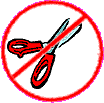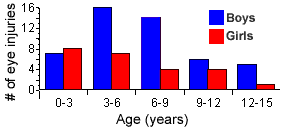 | Listen to Your Mom: "Don't Run with Scissors!" |  |
 | Listen to Your Mom: "Don't Run with Scissors!" |  |
 August 14, 2002
August 14, 2002Your Mom has probably said it many times:
She is only trying to protect you. In fact, Australian researchers would agree with your Mom. They have shown that most severe eye injuries happen at home. Dr. C.G. Thompson (Port Macquarie Eye Centre) and colleagues studied 72 cases of eye injuries that happened to children less than 16 years old. | |
| Of the 72 eye injuries:
|
 |
 According to the American Academy of
Ophthalmology, approximately 1 million accidental eye injuries occur
each year in the United States. Some of these injuries are preventable.
The Australian researchers report that several eye injuries happened to
children who were doing things they should not have been doing.
According to the American Academy of
Ophthalmology, approximately 1 million accidental eye injuries occur
each year in the United States. Some of these injuries are preventable.
The Australian researchers report that several eye injuries happened to
children who were doing things they should not have been doing.  For example, one child suffered an eye injury while lighting a
bullet with a cigarette lighter. Another child suffered an eye injury when
watching a brother crush a marble in a vice. It is likely that better
supervision of these children would have prevented the injuries.
For example, one child suffered an eye injury while lighting a
bullet with a cigarette lighter. Another child suffered an eye injury when
watching a brother crush a marble in a vice. It is likely that better
supervision of these children would have prevented the injuries.The low number of injuries at schools may be because children have good supervision. Also, many schools allow children to use only blunt scissors. At home, many children may get into trouble when they handle sharp scissors and knives. To reduce the chance of eye injuries in children, Dr. Thompson and colleagues suggest:

| |
|
References and further information:
|
| GO TO: | Neuroscience In The News | Explore the Nervous System | Table of Contents |
![[email]](./gif/menue.gif) Send E-mail |
 Fill out survey |
 Get Newsletter |
 Search Pages |
 Take Notes |